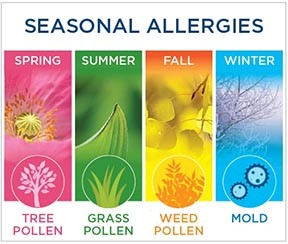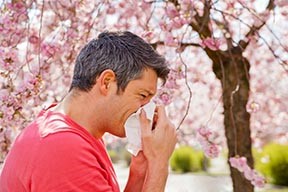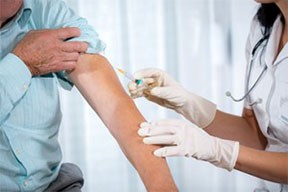Seasonal Allergy Causes
Causes of Seasonal Allergies
Seasonal Allergy Causes Overview
Allergies happen to most people at certain times of the year. One of the most common seasonal allergy reactions is called hay fever, also known as allergy rhinitis. Research from the American Academy of Allergy, Asthma, and Immunology states that about 8 percent of American adults get hay fever.
Hay Fever
When allergens trigger your immune system, it overreacts and can cause hay fever. This can be caused by different allergens that happen in haying seasons (late summer through fall) and it happens because allergens cause reactions in those who are sensitive to them.
While hay fever will show cold-like symptoms, viruses like the cold don’t actually cause hay fever. Commonly, allergens appear as pollens from plants that are wind-pollinated such as:
- Trees
- Seasonal grasses
- Flowers
- Ragweeds

Pollens that are carried by insects are too heavy and won’t stay in the air for long, so they don’t cause many allergic responses.
Common Seasonal Allergy Symptoms
Moreover, the effects of seasonal allergy are almost the same as dust, food, or fur allergies. Also, they have a range of effects that are:
- Sneezing
- Runny nose
- Itchy, watery, or swollen eyes
- Itchy throat and ear canals
- Ear or nose blockage
- Postnasal drainage
Some rare symptoms may be:
- Wheezing
- Tight chest
- Headache
- Cough
- Shortness of breath
- Fast heartbeat
People who already have asthma may have an attack during a seasonal allergy. Symptoms can last for a week or two, but harsher symptoms will come back with the exposure to allergens you are reactive to.

Origin and Causes of Seasonal Allergies
As said earlier, hay fever can be triggered by seasonal plants, pollens, and other foreign things that overwhelm the immune system. When the immune system is allergic to a particular substance, it signals it as dangerous, although it might not be. In response to this, the body will release histamines and other chemicals into the blood. These chemicals then produce the effects we know as allergies.
Spring
This is one of the best times of the year but can bring about many allergic reactions for people who are sensitive. Spring season starts early February and is until early May. Tree pollination starts early in the year, followed by grass pollination later in spring. Also, in northern places, many people react to birch tree pollen.
Other trees that produce allergens in North America are:
- Alder
- Cedar
- Horse chestnut
- Poplar
- Willow
- Birch
It’s also important to note, a rainy spring can cause molds and fungus to grow, making spores. When this happens, spores will create problems for people who are sensitive to them.
Summer
Early spring is usually when trees will grow. Grasses and weeds, however, will pollinate in late May and June. Grasses are the main cause of hay fever, which vary based on where they are in the world. In sum, the most common grasses and weeds to look out for are:
Weeds
- Ragweeds
- Cockleweed
- Tumbleweed
- Pigweed
- Russian thistle
- Sagebrush
Grasses
- Blue grasses
- Bermuda
- Orchard
- Red top
- Sweet vernal
- Timothy
Ragweed is one of the most well-known and widely spread allergens in summer and fall. Even if they are not near where you live, the tiny pollens can fly far in the air to reach you. This is because the pollen is so small it can move through the air with ease.
Smog: Air pollution in summer can cause symptoms to get worse. Pollution looks like a mix of sun and chemical exhausts from vehicles let in the atmosphere. This also hurts the ozone layer. Moreover, the summer sunshine and quiet winds make toxic clouds in some urban areas.
Fall
Ragweed is a big trigger in the fall. It can be hard to avoid because it grows all over, especially in the Midwest and East Coasts. It grows best from August up to November. The weed will grow until it is mature and then will release pollen everywhere. In many areas of America, ragweed pollen can reach the highest levels from the start to mid September.
Other plants that drop pollen in the fall time are:
- Burning bush
- Cocklebur
- Lamb’s-quarters
- Lude nettles
- Pigweed
- Sagebrush and mugwort
- Mugworts
- Sorrels
- Tumbleweed and Russian thistle
- Fat hens
- Plantains
Winter
Winter brings relief to those with allergic symptoms liked hay fever. This is in part because, in winter, outdoor allergens may become inactive. It’s also due to people spending more time indoors in the cold months. If you are sensitive to seasonal allergies, however, indoor allergens like pet dander, dust mites, mold, or bugs may trigger effects.
Seasonal Allergy Diagnosis
A hay fever diagnosis is the most common allergy. If you only have allergic effects at specific times of the year, it means that you have seasonal hay fever. Additionally, a doctor will be able to give you the best information.
People may also get tested in an allergy center if they already know what the causes are. The treatment that is done for all allergens is the same. However, you can also take steps to reduce your chance of encounters with them.

Prevention and Treatment of Seasonal Allergies
There are many ways to treat seasonal allergies, all of which depend on their severity, however, the best way is to help stop them is by:
- Reducing exposure to certain pollens
- Staying indoors when there are high allergens counts
- Washing hands and bathing often
- Closing windows and using air conditioning
- Wearing a dust mask when there is smog outside
Common treatments are:
- Decongestions
- Nasal sprays
- Inhalers
- Cortisones
In severe cases, doctors may also suggest allergy shots. Also a form of immunotherapy, shots can help desensitize the immune system to allergens.
Conclusion
Seasonal allergies can be uncomfortable to live with, so talk to a doctor if you think you have any. They will listen to your symptoms and test you to give an official diagnosis. After that, they will advise you on what actions to take to prevent effects. Lastly, they may give you prescription drugs or point you towards over-the-counter medications.
Written by: Madiha Ather Hashmi (November 08, 2020)
Sources
- ACAII (2014). “Seasonal Allergies”. American College of Allergy, Asthma & Immunology.
https://acaai.org/allergies/seasonal-allergies - WebMD Medical Reference (2020). “How to Handle Your Spring Allergies”. WebMD.
https://www.webmd.com/allergies/spring-allergies - Peter J. Delves (2020). “Seasonal Allergies”. MSD Manuals.
https://www.msdmanuals.com/home/immune-disorders/allergic-reactions-and-other-hypersensitivity-disorders/seasonal-allergies
Medically Reviewed By

Alexandria University Hospital
I have reviewed the articles on seasonalallergies.org and I would like to say that I was very surprised.
Over years, I have seen many different articles in the field of allergy, but these articles were very interesting.
These articles were really unique, they could help many people around the world to know more about seasonal allergy, symptoms, prevention and when to seek medical advice.
These articles represent an addition in the field of Health Education not only for people with allergy but also for the whole population.
Last Updated on July 5, 2023